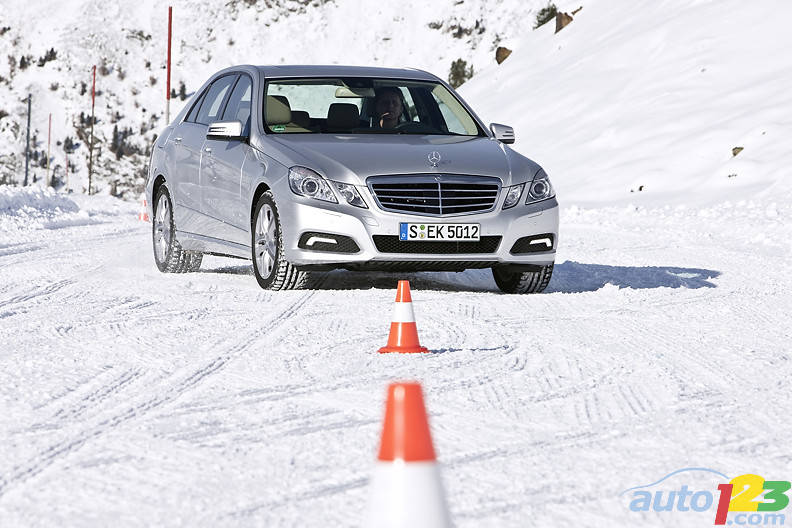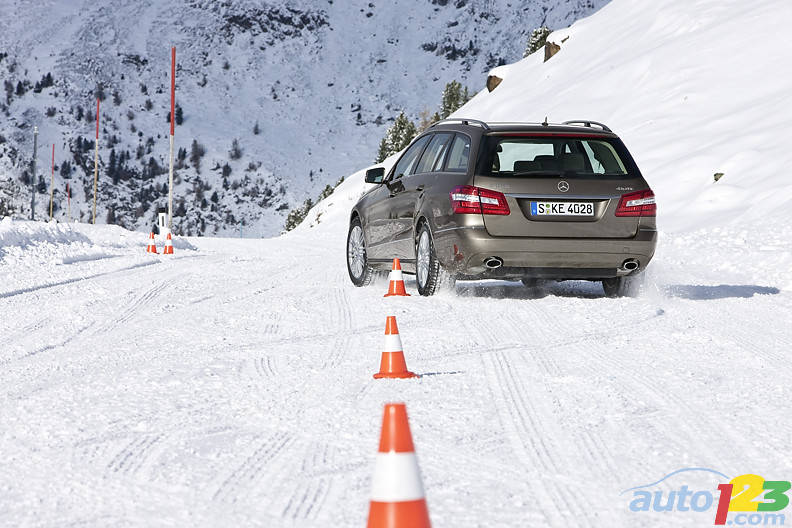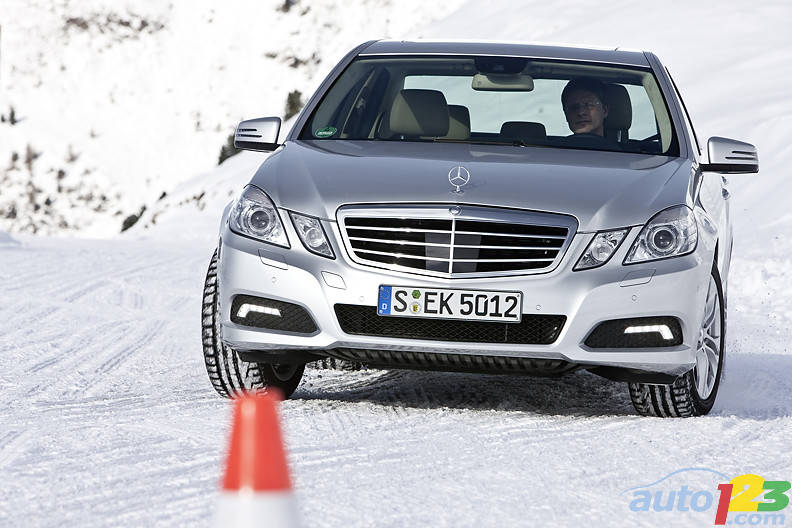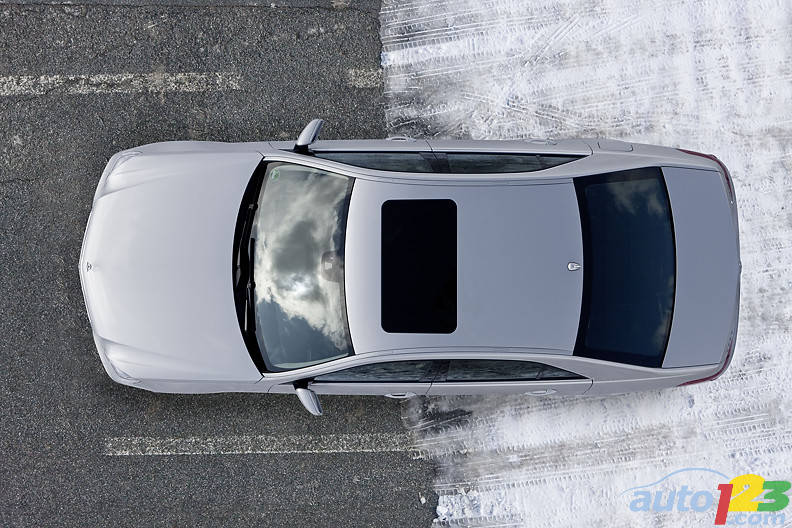Starting off on "µ-jump" surfaces – where one of the E-Class 4MATIC's axles is entirely on ice or snow and the other on asphalt – is hampered by the large differences in friction coefficient between the front and rear wheels. On vehicles with an open inter-axle differential, the axle with the lower coefficient of friction determines the transferable drive power. Whilst the multi-disc differential lock with its basic locking torque of 50 Newton metres does have a balancing effect, it is unable to compensate for these extreme differences in friction coefficient. Here again, both wheels on the axle with the lower coefficient of friction start to spin if the drive power exceeds the maximum transferable drive power at this friction coefficient. The 4ETS resolves this problem by instantly detecting spinning wheels and braking them. In this way, the braked axle with the smaller friction coefficient braces the axle with the higher friction coefficient – and the E-Class 4MATIC starts to move.
Assured handling on wintry roads
On twisting roads covered with snow and ice, vehicle stability is primarily controlled by the 4ETS system's acceleration skid control function regulating engine torque. The 4ETS control thresholds are adjusted according to the driving situation based on the vehicle's longitudinal and lateral dynamic readings as continuously measured by the ESP® sensor system. The system's configuration corresponds to the aforementioned Kamm's circle. To prevent the E-Class 4MATIC from tail-skidding, the longitudinal force when cornering must be controlled by means of engine torque regulation in such a way that there are sufficient reserves of lateral force at all times. In order to comply with this physical correlation, when cornering on road surfaces with a low friction coefficient vehicle stability is mainly controlled by the ESP® and ASR acceleration skid control systems intervening to ensure that there is always sufficient lateral force in reserve. Initially, only enough engine torque to allow the tyres to develop sufficient lateral force is transmitted to the wheels on the outside of the bend. If the ASR control function cannot restore directional stability, the ESP® system will intervene by applying the brakes to stabilise the vehicle.
In contrast to the control mechanisms triggered when cornering, considerably more longitudinal force can be provided when accelerating in a straight line, as the tyres hardly have to transfer any lateral force. What is important here is that the tyres can work in the optimum µ-slip curve range. In order to achieve this, the control thresholds for engine torque regulation are raised in this driving situation. When driving on snow-covered or icy roads with low friction coefficients, the multi-disc differential lock in the transfer case takes effect, producing an inter-axle locking torque of 50 Newton metres in the powertrain. This locking effect boosts traction considerably without having any negative impact on the control systems. When the final-drive ratios are factored in, this allows 150 Newton metres to be delivered to the wheels.
In certain wintry conditions it may become necessary to deactivate the control systems using the "ESP® OFF" switch. This is the case where high slip values are required at the wheels – when powering out of deep snow, for instance, either with or without snow chains. Even in "ESP OFF" mode drivers still have the full support of the control systems at their disposal when braking. Once back on a road surface with a normal covering of snow, the control systems should be reactivated again.
photo:Mercdes-Benz
Assured handling on wintry roads
On twisting roads covered with snow and ice, vehicle stability is primarily controlled by the 4ETS system's acceleration skid control function regulating engine torque. The 4ETS control thresholds are adjusted according to the driving situation based on the vehicle's longitudinal and lateral dynamic readings as continuously measured by the ESP® sensor system. The system's configuration corresponds to the aforementioned Kamm's circle. To prevent the E-Class 4MATIC from tail-skidding, the longitudinal force when cornering must be controlled by means of engine torque regulation in such a way that there are sufficient reserves of lateral force at all times. In order to comply with this physical correlation, when cornering on road surfaces with a low friction coefficient vehicle stability is mainly controlled by the ESP® and ASR acceleration skid control systems intervening to ensure that there is always sufficient lateral force in reserve. Initially, only enough engine torque to allow the tyres to develop sufficient lateral force is transmitted to the wheels on the outside of the bend. If the ASR control function cannot restore directional stability, the ESP® system will intervene by applying the brakes to stabilise the vehicle.
In contrast to the control mechanisms triggered when cornering, considerably more longitudinal force can be provided when accelerating in a straight line, as the tyres hardly have to transfer any lateral force. What is important here is that the tyres can work in the optimum µ-slip curve range. In order to achieve this, the control thresholds for engine torque regulation are raised in this driving situation. When driving on snow-covered or icy roads with low friction coefficients, the multi-disc differential lock in the transfer case takes effect, producing an inter-axle locking torque of 50 Newton metres in the powertrain. This locking effect boosts traction considerably without having any negative impact on the control systems. When the final-drive ratios are factored in, this allows 150 Newton metres to be delivered to the wheels.
In certain wintry conditions it may become necessary to deactivate the control systems using the "ESP® OFF" switch. This is the case where high slip values are required at the wheels – when powering out of deep snow, for instance, either with or without snow chains. Even in "ESP OFF" mode drivers still have the full support of the control systems at their disposal when braking. Once back on a road surface with a normal covering of snow, the control systems should be reactivated again.
photo:Mercdes-Benz




Article Gallery


